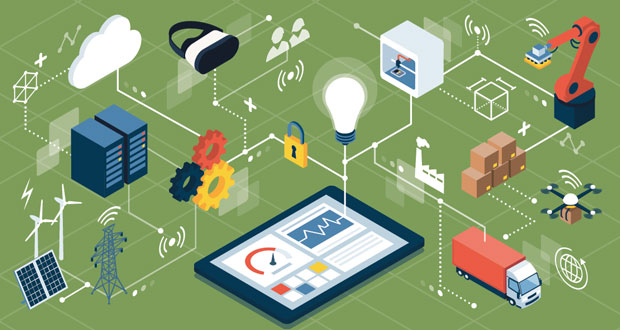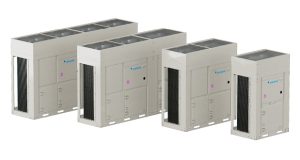COMPENSATED FLOW TEMPERATURE
The flow temperature of a LPHW heating system (and cooling systems) can be varied with external ambient temperature. As the external ambient temperature increases so the flow temperature decreases, as the heating requirement is reduced.
The flow temperature of a chilled water system can be varied with the difference in flow and return water temperature (Delta T). As the return water temperature decreases so the flow temperature can be increased (as the cooling requirement is reduced).
Design Flow temperature: 6°C
Designed Delta T: 6°C
Hence, Return T: 12°C
If the Return T drops, then the cooling demand is lower than design, so the Flow T can be allowed to increase, which makes the chiller run more efficiently.
Delta T Flow Temp
>5°C 6°C
>4°C 7°C
>3°C 8°C
FREE COOLING
When the external ambient temperature is cold enough, the first stage of cooling utilises free cooling, where external air is introduced into the building and the return air extracted to outside. Hence, warm internal air is replaced with cool external air. When the external ambient temperature is cold enough the mechanical cooling will not be required. Free cooling requires a 3 damper system and a mixing box that allows external air to mix with return air, creating the correct supply air temperature.
Another way to use free cooling is to use cool external ambient air to pre-cool the (chilled) water returning to a chiller, thereby reducing the load on the compressors (and the energy consumed). When the ambient temperature falls 1°C below the temperature of the water returning to the chiller, for example the water return temperature is 15°C and the ambient is 14°C, free cooling can be activated. A free cooling system operates by the return water being automatically diverted through the free (dry air) cooler before going to the chiller.
Free cooling is particularly effective in the UK and can bring significant energy savings, as the ambient temperature is below 15°C for almost 75 per cent of the year.
Typically, with an ambient temperature between 3°C and 5°C below the set point temperature, the compressors will completely switch off and the only energy consumed will be by the small fans on the free cooler. Free coolers can easily be retrofitted to existing chilled water systems.
ANTI-CYCLING
Where heating and cooling systems are operating very close to their set points, they will tend to operate in short bursts as the set point is continuously met. This switching on and off is very inefficient, and hence the heating and cooling plant is run for minimum periods. This tends to cause the set points to be exceeded and reduces the on/ off times.
All heating and cooling equipment in one area should be grouped and controlled together, to prevent them fighting each other.
CALIBRATION
It is very important to ensure that the sensors of the BEMS are calibrated regularly, as it controls according to its numerous sensor readings. For instance, if the external ambient temperature sensor reads 5° too low (19°C instead of 24°C) the free cooling strategy will draw in ambient air at 24°C, thinking it is 19°C. If the extract air was 23°C, it would be more economical to utilise this when cooling rather than the fresh air. In this instance, the free cooling would actually require greater mechanical cooling.
BUILDING ANALYTICS
In addition to writing energy efficient strategies in the BEMS, a data analytics package can also be added to detect inefficiencies with the system. Having remote access to the BEMS allows you to analyse what the system and plant are doing.
Building Analytics provides a smarter, data driven approach to maintaining buildings. The platform collects and amalgamates large amounts of data from disparate sources and carries out autonomous data analysis, providing stakeholders with real-time alerts and reports on the problems and inefficiencies that exist. The platform is capable of carrying out multiple simultaneous calculations (Rules) in real-time, referencing thousands of points and historic data, reporting on root cause issues.
These are then displayed on a timeline, allowing you to pinpoint when these issues occur, for how long and how frequent. You can quickly identify whether a building requires additional maintenance or has comfort issues, track issues from identification through to close out, track the performance of connected assets over time and identify areas for improvement. This enables you to improve asset performance, reduce downtime and increase operational energy savings.
Reducing energy usage and realising cost savings are hot topics for most businesses today and converting your building BMS into a BEMS can quickly provide significant paybacks. An energy and sustainability expert will guide you through the changes required to maximise heating and cooling efficiency, whilst ensuring that plant and equipment are maintained in the best condition.





